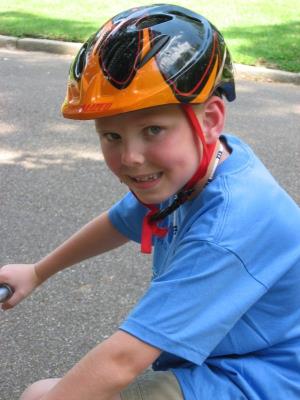
First get the size of the bike right
- Those in the know say that there should be a two to three-finger space between the rider (when seated) and the frame of the bike.
- The rider should be able to dismount and comfortably straddle the bike flat footedly.
- They shouldn’t be riding scrunched up with their knees hitting the handlebars and they shouldn’t be stretched out and unable to turn the handlebars easily.
- The assistant at your local cycle store will be able to assist you if you are unsure.
Michael Brits, a sales associate at Sportsman’s Warehouse in Cresta, Johannesburg offers this advice: “At around 2-4 years old kids can venture out on a tricycle. This is primarily to learn pedalling and get the feel of being on a bike. It’s not really the right equipment for learning balance because of the supporting wheels.
"Between the ages of 4 and 8, kids should be developing physical coordination and dexterity, balance, stopping and starting on a tricycle or training wheels.” Don’t be disheartened if your child seems to be well behind the curve. Michael says, “Children need to be mentally prepared to ride, and for some it takes time, even up to 10 years old.”
It is important to remember that children will learn differently based on their level of development and their personality. Each age will bring a different milestone, from first encountering the bike as a vehicle, to performing stunts and tricks.
Ready to go? Here’s the drill:
Find a good, safe spot to start. A gentle grassy slope is ideal. Once your child has been comfortably and confidently riding with training wheels, remove the training wheels.
- Before you do anything else, make sure your child knows how to stop the bike.
- Gently move him and the bike forward as he uses the brakes to stop, until you are sure he can do it by himself.
- Lower the seat to the point where the child can put his feet flat on the ground.
- Let your child just try balancing first, getting used to the feel of the bike without its training wheels.
- If you are on a slope, encourage him to lift his feet and just roll along gently. He can put his feet down anytime he gets nervous.
- Don’t rush onto the next steps – let him build confidence coasting and stopping on his own.
Next, get him to start using the pedals.
- From a standstill, one pedal should be up, pointing towards the handlebars. That gives him a good strong downward push to get started, while the other foot is on the ground, stabilising him.
- He’ll gradually do long and longer attempts. You can grip your child’s shoulder or the back of the saddle and run alongside him while he gets going. This ensures that he is the one doing the balancing and not you and he gets the feel of riding the bike himself; you’re just helping keep him upright.
- Tell him you’re going to let go when he’s balanced.
- You’ll be holding him for shorter and shorter periods, until he can ride on his own.
- Turning, stopping and starting smoothly may take a bit of time to get right.
Bicycle safety
Andre Botha from Johannesburg Wheelers Club says, “As our roads become busier, tolerance towards cyclists is reducing. It is definitely not advisable for kids to cycle on our roads on their own. They should be accompanied by adults.” Andre offers these tips for safe biking:
- The most important safety rule is, “No helmet means no riding”. Make sure that the helmet is not damaged and that it fits well, not loosely.
- Check your brakes before riding.
- Choose quieter, less-used roads where there is an emergency or cycling lane.
- Wear clothes that offer good visibility, in light rather than dark colours.
- When cycling on the road, always anticipate and be on the lookout for unexpected motorist behaviour.
- Obey all traffic signs and always indicate your intention, turning and stopping.
- Be careful of potholes, stones and other debris in the road. Avoid broken pavement, loose gravel and leaves, which can cause you to lose control of your bike.
- Always wear some identification band or such that has all your relevant medical and emergency contact details.
- Keep left, pass right.
- Be extra careful when turning into oncoming traffic - motorists don’t expect it.
And you too!
So, your child is cycling. Are you ready to get going on your bike, too? The benefits of riding can be great, for the whole family. “It’s truly one of the nicer exercises a family can enjoy together,” says Durban physical therapist Ravi Govender.
“Bikes are fun and simple to ride and cycling is a fantastic form of exercise. Cycling has been found to lower the risk of coronary heart disease and prevent against stroke, cancer and diabetes.
"It is mainly an aerobic activity and found to be beneficial to the lungs, the heart beats faster – and we know that a strong heart and powerful lungs form the basis of general fitness. A cycle for just 15 minutes a day can reap rewards and boost your child’s metabolism.”
Happy biking!




 Publications
Publications
 Partners
Partners










